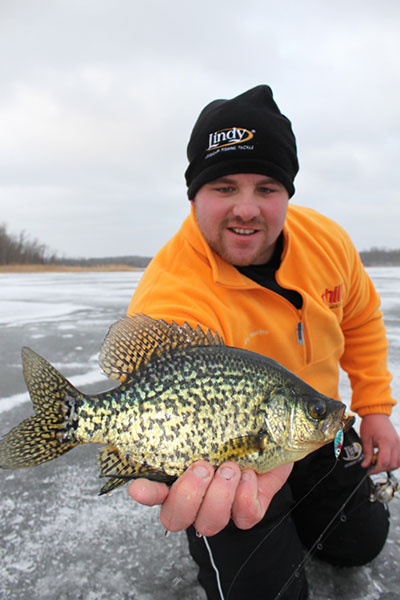Provided by PRADCO
By Nathan Shore
 When ice fishing pressure peaks, anglers should tweak presentations to fool panfish.The depth finder reveals a pair of big crappies under the hole. Anxious to get the bait back down there, you let the spoon fall right to them…and they disappear.
When ice fishing pressure peaks, anglers should tweak presentations to fool panfish.The depth finder reveals a pair of big crappies under the hole. Anxious to get the bait back down there, you let the spoon fall right to them…and they disappear.
It happens all the time. Dropping jigs and spoons too fast can spook bluegills, crappies, perch and other panfish. Using aggressive colors and tactics can spook ‘em, too. We sometimes forget we’re sitting only a few feet over their heads, giving panfish every excuse to be skittish. Standing up, sitting down, scraping buckets on the ice, hovering over the hole, then allowing light to stream down there in a big beam – it’s amazing we catch any at all.
But it’s something we have no control over that costs us the most – fishing pressure. We all know lakes that get “pounded.” Those places train panfish to develop slow and cautious reactions. The bigger a bluegill or crappie becomes, the more jigs and jigging motions it sees. They got big by being more cautious than other competitors. Those specimens tend to be taken only by the most patient competitors on top of the ice, the ones willing to slow down with packages harder for panfish to see.
On the other hand, when panfish are tightly packed, feeding competitively, and being suicidal—best to get down quick. To catch more panfish in any given situation, tune into their mood first. Then tune everything else to match it.
Tuning In
The weight, size, and color of a bait can be subtle or aggressive. A heavy jig is aggressive because it falls fast. A light one is subtle because it falls slower. A wide, flat spoon or jig is aggressive because it swims, flutters, and sends flash in all directions. A more compact version that fishes heavy for its size can be more subtle because it has no action until you make it move.
Bright, gaudy, fluorescent and glow colors are aggressive. Panfish in an aggressive, feeding mood will see them from farther away and be drawn to them. Earth tones like black, gray, brown, motor oil, smoke, pumpkinseed, watermelon and green pumpkin are subtle. They blend in, making it harder for panfish to see them. If we took a poll, we’d probably discover that most anglers think dull colors are less effective for panfish than bright chartreuse or glow orange. As a coverall statement, nothing could be farther from the truth.
Panfish can see microscopic things that you can’t. In many ways, their vision is better than yours. They train those eyes to find dull brown and olive green things all the time. A jig, spoon, or plastic trailer that blends in becomes a source of intrigue. As you jig, it appears then disappears. What was that? Arousing curiosity has the effect of stirring predatory instincts, nudging a wary, less active panfish toward a more active state.
Notice the word “natural” is avoided to describe those colors. Natural colorations of some insects, larvae, and nymphs can be yellow, bright green, flame red, or pure white. A metallic green jig with a chartreuse trailer can be more natural than we might suppose, while a dark color might be the most visible of all as it silhouettes against the ice.
Any selection of baits should allow you to tune those variables of weight, shape, and color to match moods of the fish. For instance, the Lindy Bug comes in two sizes. Both are panfish sizes and each size has 10 color options. The smaller version, with a size #14 hook, in one of the natural patterns, like Coach Dog (black on top fading to charcoal on the belly) will “hide” in most light conditions. Its edges fade into the background, appealing to neutral fish. The larger size #12 version in chartreuse—pink glow appears twice as big and is easily seen from twice the distance, appealing to active fish.
Another Lindy product—the new Foo Flyer Jig—has a flattened, horizontal-disc shape. This jig is designed to “fly,” covering water outside the diameter of the hole, sending flash in more directions. Even a low-energy lift-drop sends it swimming, making it a great search tool.
But even in dark water, blending in isn’t always a sin. The idea is to match size, color, and drop speed to the moods of the fish. The quickest way to determine those variables is with the help of plastic trailers, which can be changed quickly to play with color. Shapes can be changed to alter drop speed. Size and profile can be altered the same way, or by trimming plastic to make it smaller. All of that considered, one of the coolest things on ice for fine-tuning presentation is the Lindy Ice Jig. Each jig is packaged with 4 different, 1-inch plastic shapes in a color matching the head.
Experimentation with drop speed, color, size, and shape eventually brings more panfish in for a look, where you can gauge their moods by their reactions to things.
Shy, wary, spooky fish back off from aggressive jigging, colors, and fast drop speeds. Active, competitively feeding fish swim right up and nail a bright jig or spoon being snapped around. With all available information gathered on their state of mind, simply select the tool in your box that best matches that mood. A simple system that puts more fish on the ice every day.





